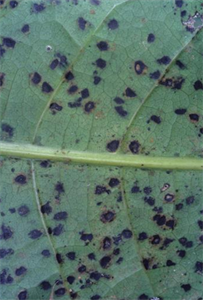- Worldwide distribution (probably). On mango. Lack of information on importance; often with the more serious anthracnose (see Fact Sheet no.09).
- Spots may merge in wet weather forming large black areas causing leaf fall.
- Leaf spots, angular to circular, up to 6 mm diameter, with small dark centres and wide greenish halos. Dark underside where spores form.
- Spread in wind and rain.
- Cultural control: Similar to anthracnose: prune canopy allowing air movement so that leaves dry quickly, and keep height <4 m; if practical, remove dead shoots, and collect fallen leaves, and burn.
- Chemical control: if required, use products as for anthracnose, e.g., copper or mancozeb, beginning when flowers first appear, continuing until the pre-harvest waiting period.
Pacific Pests, Pathogens, Weeds & Pesticides - Online edition
Pacific Pests, Pathogens, Weeds & Pesticides
Mango angular leaf spot (325)
Angular leaf spot, mango leaf spot.
Scolecostigmina mangiferae; previously known as Cercospora mangiferae and Stigmina mangiferae. Different from but easily confused with anthracnose, Glomerella cingulata (see Fact Sheet no. 09).
AUTHORS Grahame Jackson & Eric McKenzie
Photo 1 Fred Brooks, University of Hawaii at Manoa, Bugwood.org; Photos 1&2 (taken by Eric McKenzie), and used in this fact sheet, appeared previously in McKenzie E (2013) Scolecostigmina mangiferae: PaDIL - (http://www.padil.gov.au).
Produced with support from the Australian Centre for International Agricultural Research under project PC/2010/090: Strengthening integrated crop management research in the Pacific Islands in support of sustainable intensification of high-value crop production, implemented by the University of Queensland and the Secretariat of the Pacific Community.






